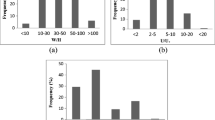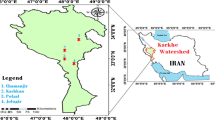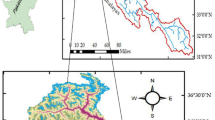Abstract
In the present research, neuro-fuzzy-based group method of data handling (NF-GMDH) has been applied to evaluate the longitudinal dispersion coefficient in rivers. The NF-GMDH model has been improved through particle swarm optimization algorithms (PSO). Effective parameters on the longitudinal dispersion coefficient including flow depth, channel width, cross-sectional average velocity, and bed shear velocity were selected to characterize a correlation between input and output variables. Field and experimental data sets have been collected from different studies. The efficiency of the proposed NF-GMDH-PSO model for both training and testing stages has been investigated. The performance of the NF-GMDH-PSO model were compared with those obtained from the differential evolutionary (DE), model tree (MT), genetic algorithm (GA), artificial neural network (ANN), and traditional empirical equations. Results analysis showed that among the artificial intelligence approach-based equations, DE and GA methods performed better than the other methodologies. The most accurate empirical equations were also introduced. NF-GMDH-PSO network also predicted the longitudinal dispersion coefficient properly and can be considered as an alternative to the aforementioned successful formulas.






Similar content being viewed by others
Abbreviations
- A :
-
Cross-sectional area
- \(a_{kj}\) :
-
Constant value for the corresponding fuzzy rule
- \(a_{k,j}^{pm}\) :
-
Parameter of the kth Gaussian function that is utilized for the jth input variable from the mth model and pth layer
- B :
-
Channel width
- BIAS:
-
Bias of the predicted values with respect to the measured ones
- \(b_{kj}\) :
-
A constant value for the corresponding fuzzy rule
- \(b_{k,j}^{pm}\) :
-
Parameter of the kth Gaussian function that is utilized for the jth input variable from the mth model and pth layer
- C :
-
Cross-sectional average concentration
- DR:
-
Discrepancy ratio
- E :
-
Error parameter of the network
- \(F_{kj} (x_{j} )\) :
-
Gaussian membership function of the kth fuzzy rule in the domain of the jth input value x j
- f :
-
A function
- H :
-
Flow depth
- h :
-
Local flow depth
- i :
-
Counter of input data set
- j :
-
Counter of input value or input value
- K :
-
Number of fuzzy rules or Gaussian functions
- k :
-
Counter of fuzzy rule or Gaussian function
- k x :
-
Dispersion coefficient in longitudinal direction
- \(k_{{xi\left( {\text{Actual}} \right)}}\) :
-
ith measured k x value
- \(k_{{xi\left( {\text{Model}} \right)}}\) :
-
Prediction of the ith measured k x value
- \(\overline{{k_{x} }}_{{\left( {\text{Actual}} \right)}}\) :
-
Mean value of the \(k_{{xi\left( {\text{Actual}} \right)}}\) values
- \(\overline{{k_{x} }}_{{\left( {\text{Model}} \right)}}\) :
-
Mean value of the \(k_{{xi\left( {\text{Model}} \right)}}\) values
- k y :
-
Dispersion coefficient in lateral direction
- k z :
-
Dispersion coefficient in orthogonal direction to the bed
- M :
-
Number of partial descriptions in each layer or total number of the measurements
- m :
-
Counter of model
- p :
-
Counter of layer
- R :
-
Correlation coefficient
- RMSE:
-
Root means square error
- U :
-
Cross-sectional average flow velocity
- \(U_{*}\) :
-
Bed shear velocity
- \(u'\) :
-
Deviation of local mean flow velocity from the cross-sectional mean flow velocity
- u k :
-
Compatibility degree of the premise part of the kth fuzzy rule
- w k :
-
Real value for kth fuzzy rule
- \(w_{k}^{pm}\) :
-
Weight parameter of the kth Gaussian function in mth model and pth layer
- x :
-
Coordinate in streamwise direction
- x j :
-
jth input value
- y :
-
Coordinate in lateral direction or final output parameter
- \(y^{ * }\) :
-
Observed value
- \(y^{pm}\) :
-
Output of the mth model in pth layer
- \(\varepsilon_{t}\) :
-
Transverse mixing coefficient
- \(\varepsilon_{t0}\) :
-
Dimensionless transverse mixing coefficient
- \(\mu_{k}^{pm}\) :
-
kth Gaussian function in the mth model and pth layer
- \(\prod {}\) :
-
Algebraic product operator
- \(\varSigma\) :
-
Summation operator
References
Abdel-Aal RE, El-Alfy E-SM (2009) Constructing optimal educational tests using GMDH-based item ranking and selection. Neurocomputing 72:1184–1197
Abdolrahimi S, Nasernejad B, Pazuki G (2014) Prediction of partition coefficients of alkaloids in ionic liquids based aqueous biphasic systems using hybrid group method of data handling (GMDH) neural network. J Mol Liq 191:79–84
Amanifard N, Nariman-Zadeh N, Farahani MH, Khalkhali A (2008) Modeling of multiple short-length-scale stall cells in an axial compressor using evolved GMDH neural networks. Energ Convers Manag 49(10):2588–2594
Astakhov VP, Galitsky VV (2005) Tool life testing in gundrilling: an application of the group method of data handling (GMDH). Int J Mach Tool Manu 45:509–517
Azamathulla HM, Ab Ghani A (2011) Genetic programming for predicting longitudinal dispersion coefficients in streams. Water Resour Manag 25(6):1537–1544
Azamathulla HM, Wu FC (2011) Support vector machine approach for longitudinal dispersion coefficients in natural streams. Appl Soft Comput 11(2):2902–2905
Deng ZQ, Singh VP, Bengtsson L (2001) Longitudinal dispersion coefficient in straight rivers. J Hydraul Eng 127(11):919–927
Deng ZQ, Bengtsson L, Singh VP, Adrian DD (2002) Longitudinal dispersion coefficient in single-channel streams. J Hydraul Eng 128(10):901–916
Elder JW (1959) The dispersion of marked fluid in turbulent shear flow. J Fluid Mech 5(4):544–560
Etemad-Shahidi A, Taghipour M (2012) Predicting longitudinal dispersion coefficient in natural streams using M5′ model tree. J Hydraul Eng 138(6):542–554
Fischer HB (1967) The mechanics of dispersion in natural streams. J Hydraul Div 93(HY6):187–216
Fischer HB (1968) Dispersion predictions in natural streams. J Sanit Eng Div 94(5):927–944
Fischer HB (1975) Discussion of simple method for predicting dispersion in streams by R. S. McQuivey and T. N. Keefer. J Environ Eng Div 101(3):453–455
Fischer HB, List EJ, Koh RCY, Imberger J, Brooks NH (1979) Mixing in land and costal waters. Academic Press, New York, pp 104–138
Graf JB (1995) Measured and predicted velocity and longitudinal dispersion at steady and unsteady flow, Colorado River, Glen Canyon Dam to Lake Mead. J Am Water Resour Assoc 31(2):265–281
Guymer I (1998) Longitudinal dispersion in sinuous channel with changes in shape. J Hydraul Eng 124(1):33–40
Hwang HS (2006) Fuzzy GMDH-type neural network model and its application to forecasting of mobile communication. Comput Indus Eng 50(4):450–457
Iba H, de Garis H (1996) Extending genetic programming with recombinative guidance. In: Angeline P, Kinnear K (eds) Advances in genetic programming, vol 2. MIT Press, Cambridge, pp 69–88
Iwasa Y, Aya S (1991) Predicting longitudinal dispersion coefficient in open-channel lows. Proceedings of International Symposium on Environmental Hydraulics, Hong Kong, December 16–18, 1991. A.A. Balkema, Rotterdam, pp 505–510
Kalantary F, Ardalan H, Nariman-Zadeh N (2009) An investigation on the Su-NSPT correlation using GMDH type neural networks and genetic algorithms. Eng Geol 104:144–155
Kashefipour SM, Falconer RA (2002) Longitudinal dispersion coefficients in natural channels. Water Res 36(6):1596–1608
Koussis AD, Rodríguez-Mirasol J (1998) Hydraulic estimation of dispersion coefficient for streams. J Hydraul Eng 124(3):317–320
Li X, Liu H, Yin M (2013) Differential evolution for prediction of longitudinal dispersion coefficients in natural streams. Water Resour Manag 27(15):5245–5260
Lin JS (2012) A novel design of wafer yield model for semiconductor using a GMDH polynomial and principal component analysis. Expert Syst Appl 39(8):6665–6671
Liu H (1977) Predicting dispersion coefficient of streams. J Environ Eng Div 103(1):59–69
Madala HR, Ivakhnenko AG (1993) Inductive learning algorithms for complex systems modeling. CRC Press, Boca Raton
McQuivey RS, Keefer TN (1974) Simple method for predicting dispersion in streams. J Environ Eng Div 100(4):997–1011
Nagasaka K, Ichihashi H, Leonard R (1995) Neuro-fuzzy GMDH and its application to modeling grinding characteristics. Int J Prod Res 33(5):1229–1240
Najafzadeh M, Azamathulla HM (2013) Neuro-fuzzy GMDH systems to predict the scour pile groups due to waves. J Comput Civil Eng. doi:10.1061/(ASCE)CP.1943-5487.0000376
Najafzadeh M, Lim SY (2015) Application of improved neuro-fuzzy GMDH to predict scour downstream of sluice gates. Earth Sci Inform 8(1):187–196
Najafzadeh M, Zahiri A (2015) Neuro-fuzzy GMDH based evolutionary algorithms to predict flow discharge in straight compound channels. J Hydrol Eng. doi:10.1061/(ASCE)HE.1943-5584.0001185
Najafzadeh M, Barani GA, Hessami Kermani MR (2013a) Abutment scour in live-bed and clear-water using GMDH Network. Water Sci Technol 67(5):1121–1128
Najafzadeh M, Barani GA, Azamathulla HM (2013b) GMDH to predict scour depth around vertical piers in cohesive soils. Appl Ocean Res 40:35–41
Nordin CF, Sabol GV (1974) Empirical data on longitudinal dispersion in rivers. Water-resources investigations 74-20. U.S. Geological Survey, Reston
Ohtani T, Ichihashi H, Miyoshi T, Nagasaka K (1998) Orthogonal and successive projection methods for the learning of neurofuzzy GMDH. Inform Sci 110:5–24
Onwubolu GC (2008) Design of hybrid differential evolution and group method of data handling networks for modeling and prediction. Inform Sci 178(18):3618–3634
Papadimitrakis I, Orphanos I (2004) Longitudinal dispersion characteristics of rivers and natural streams in Greece. Water Air Soil Pol Focus 4(4–5):289–305
Piasecki M, Katopodes ND (1999) Identification of stream dispersion coefficients by adjoint sensitivity method. J Hydraul Eng 125(7):714–724
Riahi-Madvar H, Ayyoubzadeh SA, Khadangi E, Ebadzadeh MM (2009) An expert system for predicting longitudinal dispersion coefficient in natural streams by using ANFIS. Expert Syst Appl 36(4):8589–8596
Rutherford JC (1994) River mixing. Wiley, Chichester
Sahay RR (2011) Prediction of longitudinal dispersion coefficients in natural rivers using artificial neural network. Environ Fluid Mech 11(3):247–261
Sahay RR, Dutta S (2009) Prediction of longitudinal dispersion coefficients in natural rivers using genetic algorithm. Hydrol Res 40(6):544–552
Seo IW, Baek KO (2004) Estimation of the longitudinal dispersion coefficient using the velocity profile in natural streams. J Hydraul Eng 130(3):227–236
Seo IW, Cheong TS (1998) Predicting longitudinal dispersion coefficient in natural streams. J Hydraul Eng 124(1):25–32
Seo IW, Cheong TS (2001) Moment-based calculation of parameters for the storage zone model for river dispersion. J Hydraul Eng 127(6):453–465
Taylor GI (1953) Dispersion of soluble matter in solvent flow through a tube. Proc R Soc Lond Ser A 219:186–203
Taylor GI (1954) The dispersion of matter in turbulent flow through a pipe. Proc R Soc Lond A 223(1155):446–468
Toprak ZF, Cigizoglu HK (2008) Predicting longitudinal dispersion coefficient in natural streams by artificial intelligence methods. Hydrol Processes 22(20):4106–4129
Wang HB, Xu AJ, Ai LX, Tian NY (2012) Prediction of endpoint phosphorus content of molten steel in BOF using weighted K-means and GMDH neural network. J Iron Steel Res Int 19(1):11–16
Witczak M, Korbicz J, Mrugalski M, Patton RJ (2006) A GMDH neural network-based approach to robust fault diagnosis: application to the DAMADICS benchmark problem. Control Eng Pract 14(6):671–683
Yotsukura N, Fischer HB, Sayre WW (1970) Measurement of mixing characteristics of the Missouri River between Sioux City, Iowa and Plattsmouth, Nebraska. U.S. Geological Survey Water-supply paper 1899-G. U.S. Government Printing Office, Washington, DC
Author information
Authors and Affiliations
Corresponding author
Rights and permissions
About this article
Cite this article
Najafzadeh, M., Tafarojnoruz, A. Evaluation of neuro-fuzzy GMDH-based particle swarm optimization to predict longitudinal dispersion coefficient in rivers. Environ Earth Sci 75, 157 (2016). https://doi.org/10.1007/s12665-015-4877-6
Received:
Accepted:
Published:
DOI: https://doi.org/10.1007/s12665-015-4877-6




